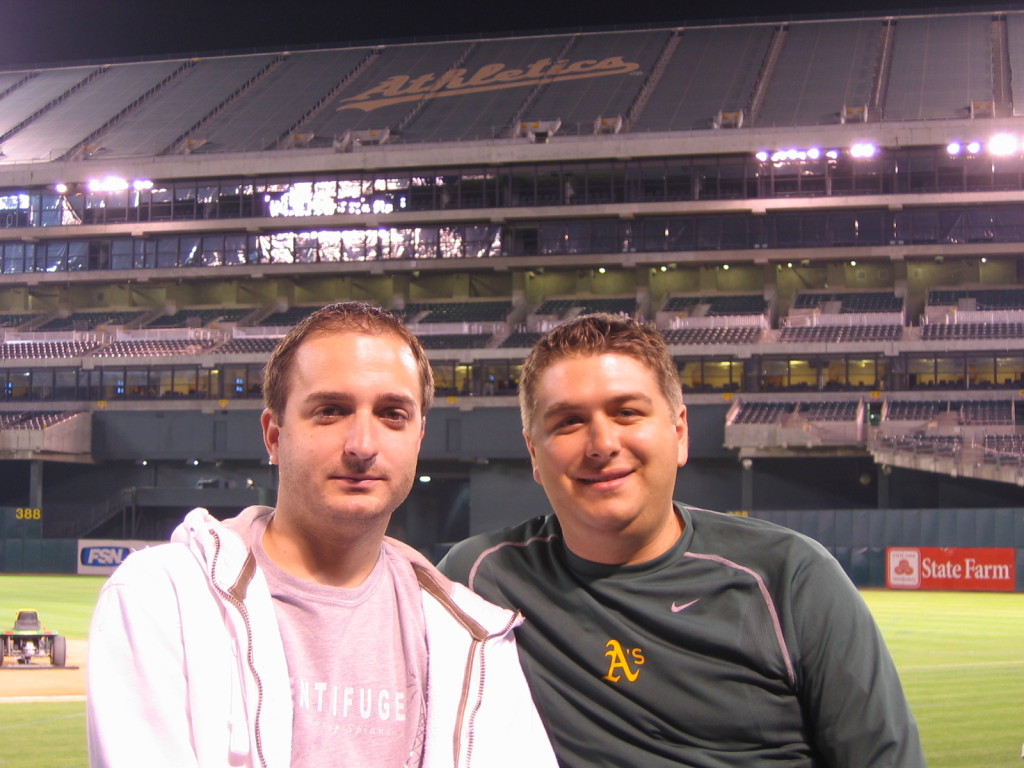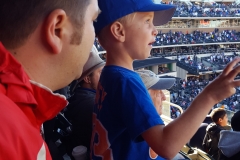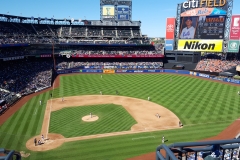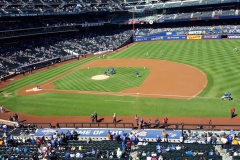
August 28, 2007: Oakland, California
The Oakland Coliseum, also known as the Oakland-Alameda County Coliseum (1968-1997, 2009-2010, and 2016-present), Network Associates Coliseum (1998-2004), McAfee Coliseum (2005-2008) and O.co Coliseum (2011-2015), is best known for its expansive foul territory and frequent plumbing problems. My first memory of the A’s and their home ballpark was the 1988 American League Championship. Oakland and their high octane offense, led by Bash Brothers Mark McGwire and Jose Canseco, were facing the American League East champion Boston Red Sox. The Oakland Coliseum was a picturesque ballpark with the Alameda Hills behind centerfield. The first two games of the series were played at 5:05 local time, 8:05 on the East Coast. I was 7, but was locked in from the start. I had to watch my favorite player, Jose Canseco, who had just completed MLB’s first 40 home run, 40 stolen base season. The A’s went on to sweep the Red Sox 4-0, only to lose the World Series to the underdog Los Angeles Dodgers. Kirk Gibson’s Game 1 home run off A’s closer and future Hall of Famer Dennis Eckersley in the 9th was a gut punch the A’s never recovered from. The A’s continued their American League dominance, winning the 1989 and 1990 pennants and 1989 World Series against their Bay Bridge rival, the San Francisco Giants. The A’s success led to 2.9 million in attendance during the 1990 season, a high watermark they haven’t been close to since. The next stretch of winning A’s baseball would be built by a washed-out prospect who played 37 games for the 1989 World Champion A’s. Billy Beane, with the help of analysts (or was it Jonah Hill?) brought Sabermetrics to the mainstream. Beane and his A’s were the subject of Michael Lewis’s Moneyball, a book all baseball fans should read. Beane built the 1998-2006 A’s around the pitching of Barry Zito, Tim Hudson, Mark Mulder and identifying undervalued assets across baseball’s landscape. The A’s were operating on a shoestring budget, unable to afford talented young players past their arbitration years, or free agent veterans seeking the highest bidder. If Beane could trade a player with two remaining seasons of control for one with four and not sacrifice value on the field, he would send that player packing. Beane and his staff brought a commodities-trading mentality to Major League Baseball. This cold and calculating approach wore on A’s fans despite the team’s success on the field. The A’s attendance continued to decrease as their home ballpark served as a source of ridicule. In 2009, MLB Commissioner Bud Selig announced a study to assess potential ballpark locations for the A’s. To this day its findings have not been published.
Heading to the Coliseum on the BART (Bay Area Rapid Transit) is a communal experience. Fans wearing green and gold exit the Coliseum Station stop and walk across a pedestrian bridge adorned with barbed wire. Who’s ready for baseball? The Coliseum was built in 1966 as the home of the Oakland Raiders before welcoming the A’s from Kansas City in 1968. Concrete must have been affordable at the time because the Coliseum has a ton. It’s a cold ballpark, dark and drab. The ballpark’s lighting is designed more for football. In 2006, the A’s began placing tarps over Upper Deck sections in an attempt to create an intimate fan experience which decreased capacity attendance to 35,067. The marketing department sells an A’s game at the Coliseum as “Green Collar Baseball.” With modern ballparks becoming mall-parks, it’s tough to find a pure baseball experience. Oakland is going counter-culture; the Coliseum is trying to be the dive bar that’s the place to be for baseball hipsters.
I shared my Coliseum experience with 20,541 fellow Green Collar aficionados as the A’s and Toronto Blue Jays played the second game of a three-game series. Both lineups featured future Hall of Famers Frank Thomas for the Jays and Mike Piazza for the A’s in the DH spot. Oakland jumped out to an early 2-0 lead in the 1st, via Jack Cust’s two-run single off Toronto’s starter Jessie Litsch. Toronto’s offense would run off five unanswered against Oakland’s staff; Lyle Overbay’s 8th-inning two-run double and Aaron Hill’s sacrifice fly put the Jays ahead 5-2. The A’s showed fight in the 9th, scoring two runs off Jays closer Jeremy Accardo, but with runners on first and second, A’s third baseman Jack Hannahan grounded out to end the game. Blue Jays 5, A’s 4.
When ranking the current MLB ballparks, the Coliseum comes in 29th for me. The A’s dwindling attendance creates a catch-22 for the A’s ownership group. Lack of attendance decreases potential revenues that could be utilized to fund a new ballpark. Earlier this month, the A’s Coliseum roommates, the Oakland Raiders, filed relocation papers to move to Las Vegas…this after the Raiders built the monstrosity fans called Mount Davis in center field, ruining the view of Oakland’s Alameda Hills. Refurbishing the Coliseum is probably not an option since the surrounding area is a sea of parking lots, and it would go against the trend of downtown ballparks. The A’s are also limited in potential landing spots because Northern California’s territorial rights are split between the A’s and the San Francisco Giants. A new ballpark on the waterfront in Jack London Square would give the A’s a baseball-only downtown ballpark, but ownership has not communicated a concrete plan for the future. In the meantime, the A’s and their loyal fans continue to operate in baseball and ballpark purgatory.





